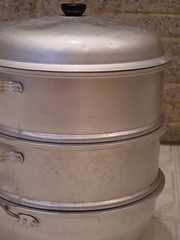25 Sep / My rise as steam queen

This is me. This is the hole I made in the bottom of my mom’s steamer pot. And I’m looking at you right through it. You’d think it would be pretty hard to bore a hole through metal. Think again. When it comes to me in the kitchen, anything is possible.
I was trying out my mum’s recipe for an Indonesian cake called kue lapis sagu (literally layered cake; more on this later), and like many Asian cakes, it’s steamed not baked. Here is a picture of my mum’s trusty steamer before aforementioned hole. It’s a traditional contraption that I’ve also seen in many Asian kitchens. Sadly, it has now been relegated to the garbage can.
But what can you do? Some novice experiences proceed without a hitch while others … well, I’m sure anyone who has been experimental in the kitchen can identify.
I hate to admit steaming is not new to me. My mum steamed lots of foods (fish, rice bundles, sweets, etc.) when I was growing up, and I can still recall helping her make cupcakes when I was wee high. But I rarely steamed anything in my own kitchen B.C. (before cookbook). Looking on the bright side, this mishap was an excellent lesson in the do’s and don’ts of steaming. The number one “do” being “do check on the water level at regular intervals to ensure it doesn’t run dry and burn a hole right through the bottom of your pot.” (One caveat though, you need to make sure the liquid doesn’t touch the bottom of the food being steamed.)
And mind this very important note I gave to myself: the release of a constant stream of steam doesn’t mean the water level in the pot is sufficiently high (yes, that was my downfall.) I have since recovered from my first steaming fiasco and steaming has become quite a fixture in my cooking repertoire as I have discovered it is a very popular cooking method across all Asian cuisines. And why not? Steaming is fast and easy, healthy, and allows food to remain moist and flavorful. Thanks to some wonderful teachers, you can now call me steam queen!
So far, I have learned to make:
Steamed sponge cake
Egg crepe rolls
Suman (coconut sticky rice cakes)
Now, you don’t have to go out and buy a fancy three tiered aluminum steamer like my mum’s. You can easily steam most foods with an inexpensive bamboo steamer, a stockpot with a pasta insert, or an asparagus steamer.
Or you could experiment with some of these common implements you might already have lying around in your kitchen:
- Use a roasting pan with a rack and a lid. Line rack with foil. Poke holes in the foil and place rack in roasting pan.
- Use a collapsible vegetable steaming rack and place in a skillet or wok.
- Place an oven-proof bowl upside down in a wok or other pan. Place a plate on top.
However, if you would like to invest in one–especially if you’re planning on steaming often, these nifty steamers are easy to use and hold a lot–they are available in Chinatown for about $50.
I know ’cause I had to buy my mum another one just the other day.











why don’t you try using microwave?
I don’t own a microwave now (I don’t like to have one), when I used to have one I ‘steamed fish’ in it. I am sure you can try that with the steam sponge cake. I actually tried it before but it did not turn out well because my microwave and too OLD and did not have the rotating function.
Hi Cindy, thanks for your suggestion. I will try it in the microwave. Steaming is very laborious and today it’s all about convenience and speed.
wow gd advice
u rock sister